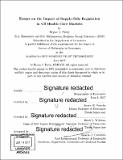| dc.contributor.advisor | James M. Poterba and Heidi L. Williams. | en_US |
| dc.contributor.author | Perry, Bryan J | en_US |
| dc.contributor.other | Massachusetts Institute of Technology. Department of Economics. | en_US |
| dc.coverage.spatial | n-us--- n-us-nc | en_US |
| dc.date.accessioned | 2017-09-15T15:30:08Z | |
| dc.date.available | 2017-09-15T15:30:08Z | |
| dc.date.copyright | 2017 | en_US |
| dc.date.issued | 2017 | en_US |
| dc.identifier.uri | http://hdl.handle.net/1721.1/111346 | |
| dc.description | Thesis: Ph. D., Massachusetts Institute of Technology, Department of Economics, 2017. | en_US |
| dc.description | Cataloged from PDF version of thesis. | en_US |
| dc.description | Includes bibliographical references. | en_US |
| dc.description.abstract | In this thesis, I take up the question of how government regulations impact the supply side of the US health care market. In Chapter 1, I exploit the Medicare rural floor, a discontinuity in geographic adjustments to Medicare payments to hospitals, in a regression kink design to estimate the impact of Medicare reimbursement rate changes on the level and mix of hospital services provided. I find that hospitals respond to higher Medicare reimbursement by admitting more Medicare patients, but that the average duration of a patient stay declines. I also document a previously unstudied spillover of Medicare reimbursement on the volume of admitted patients with non-Medicare insurance. For the remainder of my thesis, I turn my attention to Certificate of Need regulation-restrictions on capital investment-in North Carolina. I use newly collected data on the MRI market in North Carolina to estimate the dynamic effects of marginal relaxations of CON restrictions on provider investment. Thresholds in the regulatory approval process enable me to employ a regression discontinuity model to estimate the effects of CON on hospitals and patients. In Chapter 2 I document three key findings. First, health care providers essentially always adopt newly allowed MRI scanners within two years of a CON approval. This suggests that CON regulations are a binding constraint on investment. Second, there is an active market for unregulated mobile MRI scanners that enable health care providers to mitigate the impact of CON restrictions. Finally, MRI utilization increases after new machines are acquired, indicating CON rules affect not only hospital investment but also medical practice. In Chapter 3 I combine the North Carolina regulatory data with patient-level Medicare claims data to estimate the effects of CON on patient care. Hospitals do not offset reductions in MRI services with increased usage of alternative diagnostic imaging technologies. CON regulations reduce the number of scans patients with lower back pain receive by more than a third in the month following their first hospital encounter, reducing medical spending by roughly $400. There is no evidence that this decrease in the intensity of care comes at the cost of increased future lower back pain. | en_US |
| dc.description.statementofresponsibility | by Bryan J. Perry. | en_US |
| dc.description.tableofcontents | 1. Hospital Responses to Medicare Reimbursement Rate Changes: New Evidence from Medicare's Rural Floor -- 2. Certificate of Need Regulation and Hospital Behavior: Evidence from MRIs in North Carolina -- 3. The Impacts of Certificate of Need Regulation on Patient Care: MRI Utilization in North Carolina. | en_US |
| dc.format.extent | 144 pages | en_US |
| dc.language.iso | eng | en_US |
| dc.publisher | Massachusetts Institute of Technology | en_US |
| dc.rights | MIT theses are protected by copyright. They may be viewed, downloaded, or printed from this source but further reproduction or distribution in any format is prohibited without written permission. | en_US |
| dc.rights.uri | http://dspace.mit.edu/handle/1721.1/7582 | en_US |
| dc.subject | Economics. | en_US |
| dc.title | Essays on the impact of supply-side regulation in US health care markets | en_US |
| dc.type | Thesis | en_US |
| dc.description.degree | Ph. D. | en_US |
| dc.contributor.department | Massachusetts Institute of Technology. Department of Economics | |
| dc.identifier.oclc | 1003291018 | en_US |
